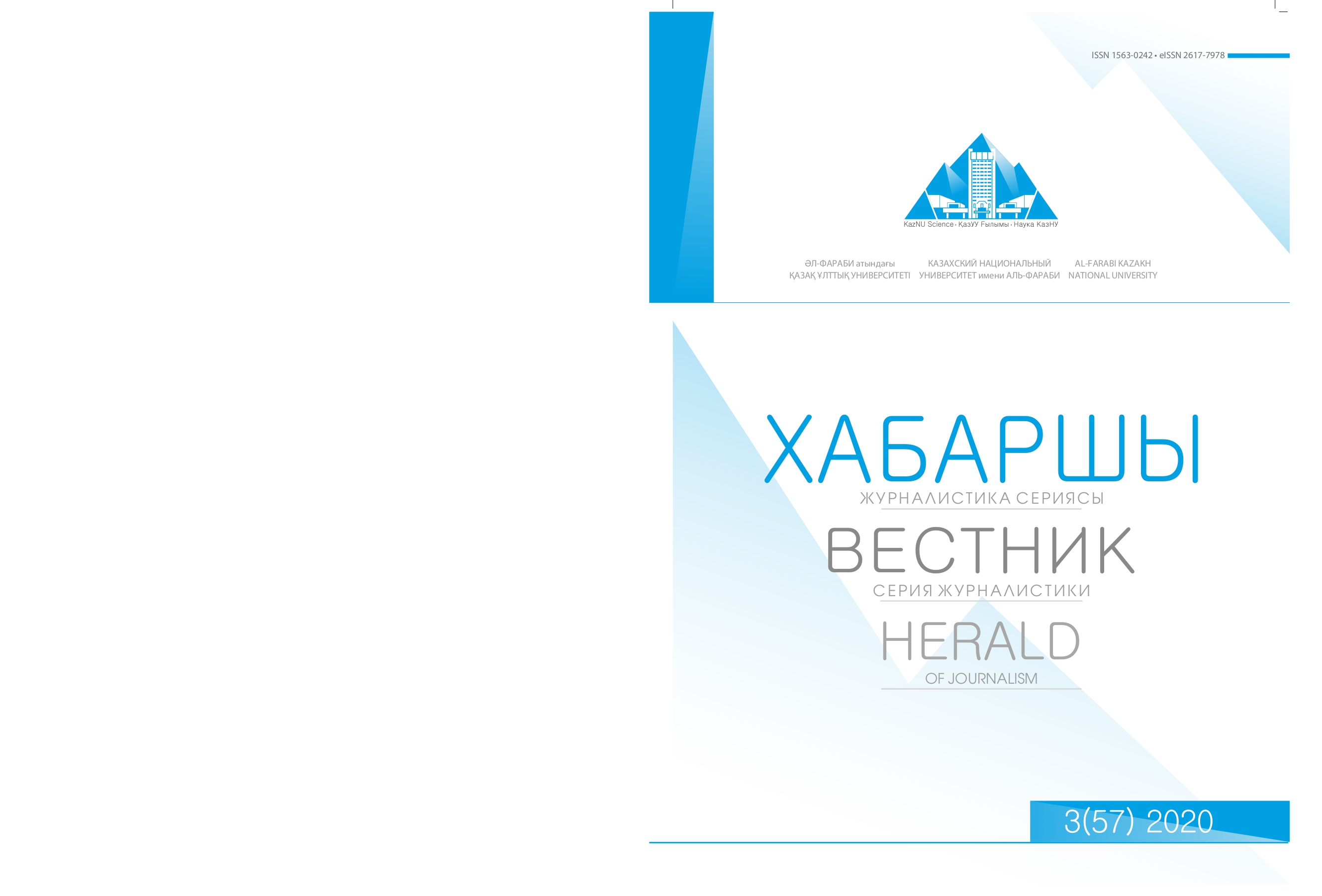The principles of creating a country image in the media: linguistic-cognitive aspect
DOI:
https://doi.org/10.26577/HJ.2020.v57.i3.07Keywords:
image, media space, PR, country image, linguo-cognitive units.Abstract
The article considers the methods and techniques of creating an image in the media space. Particular emphasis is placed on the principles of the formation of a country image, as well as the linguo-cognitive aspects involved in its construction. Thus, the most common techniques are analyzed, including the use of epithets, antithesis, periphrases, comparisons, metaphors. The article demonstrates a review of the modification of journalistic creativity under the influence of linguistic units, reveals the concept of “im- age” created by media workers (PR-workers and journalists), classifies the principles of dissemination of image-forming texts.
The purpose of the study was to identify the role of the linguo-cognitive aspect in the process of building a country image. In addition, the author analyzed the classification of approaches to building a media image of the state in the media. The formation of the image with the help of linguo-cognitive units, as the author sees it, can take a dangerous and destructive effect on the audience, have a strong conflictogenic mood. This direction was also considered by the author in this work.
When writing a scientific publication, a number of research methods were used, including theoreti- cal and methodological, comparative, logical, complex and content analysis. An analysis of theoretica literature was also carried out. The author resorted to synthesis, analysis, analogy, classification and the historical method, deduction, induction, abstraction.
The study revealed that the linguo-cognitive features of media texts affect the virtual picture of the world, and set the information agenda. The linguistic-cognitive aspect of image-forming texts once again confirms the ideological function of the media. In addition, linguistic-cognitive methods can be consid- ered not only conflictogenic means of constructing images, but also very effective when used rationally. The practical significance of the work lies in the ability to use this material as additional when study-
ing the aspects of image building, which is relevant at the moment both for journalism and for PR.
References
Басовская Е.Н. 2004. Творцы черно-белой реальности: о вербальной агрессии в средствах массовой информации.
Критика и семиотика. – Новосибирск, 257-263.
Бзежинский Зб. 2010. Выбор. Мировое господство или глобальное лидерство. – М., 190-198. Вартанова Е.Л. 2009. Теория СМИ. Актуальные проблемы. – М., 82
Гринберг Т.Э. 2008. Образ страны или имидж государства: поиск конструктивной модели. – М., 66.
Дагаева Е.А. 2011. Имидж как социально-психологический феномен: теоретико-методологические аспекты изучения // Социология. Психология. Философия. Вестн. Нижегор. ун-та им. Н.И. Лобачевского. – № 4 (1), 320-336.
Замятин Д.Н. 2003. Гуманитарная география: Пространство и язык географических образов. – СПб., 57. Липпман У. 2004. Общественное мнение. – М., 62-85.
Почепцов Г. Г. 2004. Имиджелогия. – М., 294-320.
Boulding K. 1956. The Image. Knowledge in Life and Society. Ann Arbor: University of Michigan, 173.
Cottam M.L., Cottam R.W. 2001. Nationalism and Politics: the Political Behavior of Nation States. Boulder. – L., 57.
Cotírlea D. A. 2015. Country image vs. country brand: differences and similarities // Ecoforum. Vol. 4, Special Issue 1,
36-45.
Jenes B., Malota Ph.D. E. 2010. Measuring Country Image - Theory and Practice. — N.Y., 81-83.
Kunczik M. 2001. Globalization: News Media, Images of Nations and the Flow of International Capital with Special Reference to the Role of Rating Agencies. – Hamburg, 106-109.
Nye J. 2004. Soft Power: The Means to Success in World Politics. — N.Y., 191.
References
Bakulev G.P. (2005) Massovaya kommunikatsiya: Teorii i kontseptsii: posobiye dlya studentov vuzov. [Mass communication: Theories and concepts: a manual for university students]. Moscow, 176.
Basovskaya E.N. (2004) Tvortsy cherno-beloy real’nosti: o verbal’noy agressii v sredstvakh massovoy informatsii. Kritika i semiotika [Creators of black and white reality: about verbal aggression in the media. Criticism and semiotics]. Novosibirsk, 257.
Bzezhinskiy Zb. (2010) Vybor. Mirovoye gospodstvo ili global’noye liderstvo [Choice. World domination or global leadership].
Moscow, 190-198.
Vartanova E.L. (2009) Teoriya SMI. Aktual’nyye problem [Theory of the media. Actual problems]. Moscow, 82.
Dagayeva Ye.A. (2011) Imidzh kak sotsial’no-psikhologicheskiy fenomen: teoretiko-metodologicheskiye aspekty izucheniya [Image as a socio-psychological phenomenon: theoretical and methodological aspects of the study] // Vestn. Nizhegor. un-ta im. N.I. Lobachevskogo. № 4 (1), 320-336.
Grinberg T.E. (2008) Obraz strany ili imidzh gosudarstva: poisk konstruktivnoy modeli [The image of the country or the image of the state: the search for a constructive model]. Moscow, 66.
Zamyatin D.N. (2003) Gumanitarnaya geografiya: Prostranstvo i yazyk geograficheskikh obrazov [Humanitarian Geography: The Space and Language of Geographical Images]. Saint-Petersburg, 57.
Lippman W. (2004) Obshchestvennoye mneniye [Public Opinion]. Moscow, 62-85. Pocheptsov G. G. (2004) Imidzhelogiya [Imageology]. Moscow, 294-320.
Boulding K. (1956) The Image. Knowledge in Life and Society. Ann Arbor: University of Michigan, 173.
Cottam M.L., Cottam R.W. (2001) Nationalism and Politics: the Political Behavior of Nation States. Boulder. L., 57.
Cotírlea D. A. (2015) Country image vs. country brand: differences and similarities // Ecoforum. Vol. 4, Special Issue 1, 36-45. Jenes B., Malota Ph.D. E. (2010) Measuring Country Image - Theory and Practice. N.Y., 81-83.
Kunczik M. (2001) Globalization: News Media, Images of Nations and the Flow of International Capital with Special Reference to the Role of Rating Agencies. Hamburg, 106-109.
Nye J. 2004. Soft Power: The Means to Success in World Politics. N.Y., 191.




